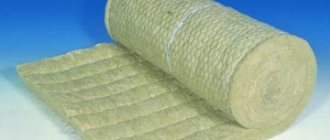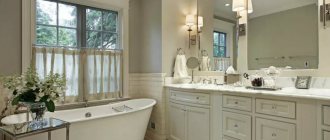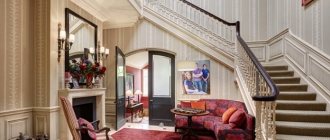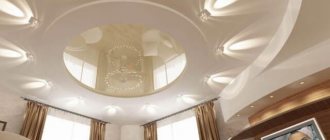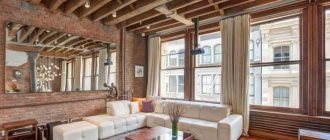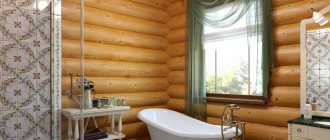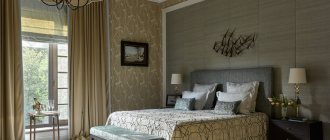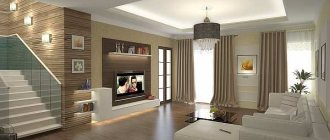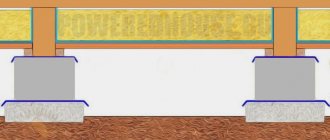- Wooden covering
After completing the exterior work during the construction of a country house, you need to begin a complex but necessary process - interior decoration. Typically, interior design begins with the question of how to decorate the ceiling in a private house. The proposed article will help you decide on the choice of finishing material.
Coloring
Decorating ceilings with paint is the simplest and most affordable finishing method. Most often, water-dispersed compositions are used for this purpose. Their cost is relatively low. In addition, such materials demonstrate excellent resistance to water and temperature changes. It will only take a few hours for the paint to dry. Water-dispersed compositions do not emit harmful substances, and their range allows you to choose a shade that will harmonize with the interior of the room. The material can be applied to any surface except metal, due to the risk of corrosion.
Painting the ceiling surface
The main disadvantage of this method of finishing ceilings is the need to completely remove the old coating, for example, whitewash or plaster layer. A high-quality preliminary leveling will also be required, since any defects on the painted surface will be visible. The paint coating regularly requires updating, that is, it will have to be tinted annually. This is especially true for ceilings in kitchens, where grease will settle during cooking.
Sheathing with plasterboard
This type of finishing differs from board design in that it is necessary to use a galvanized profile for gypsum boards to prevent deformation of the ceiling surface.
The work is carried out in stages:
- The profile is mounted along the beams using hangers or U-shaped brackets. The transverse profiles are installed so that a sheathing is formed, having dimensions that allow the gypsum boards to be joined.
- Drywall is cut with a sharp knife, hacksaw or jigsaw. Fix the sheets to the sheathing with self-tapping screws, trying to immerse them in the material to a depth of 1 millimeter.
- The joints between them are puttied using sickle tape, sanded and again covered with finishing putty. You also need to rub out the fixation points for screws and other irregularities.
- The ceiling is coated with water-based or acrylic-based interior paint using a roller. To create a more even tone, apply a second layer.
If the ceiling lining in a wooden house in the kitchen is made of plasterboard and painted with water-based paint, it will look good if the fillets are selected well.
Different types of ceiling cladding along beams are often combined, creating a unique design in the room.
Plastering
Decorating the ceiling with plaster mixtures is also a fairly popular procedure. Using this material you can not only decorate the surface, but also level it. In addition, plaster compositions do not burn and do not support combustion, do not emit toxic substances, and are relatively inexpensive.
Important! Such work requires two people, as well as some experience - it will be difficult for a novice home craftsman to do everything perfectly smooth.
Finishing the ceilings in an apartment with plaster is impossible if the ceiling is more than 5 cm thick. Too large a layer of material can significantly reduce the service life of the coating. In addition, the plaster “steals” the height of the walls a little.
What determines the choice of finish?
Stucco molding with gilding will fit perfectly into a similar interior
You may be interested in how the ceiling is decorated in Berlin, Paris or other major cities of the world, but often the choice of the best option depends not only on fashion trends, but also on other factors.
Among them I will note the following:
- The state of the ceiling, namely, the degree of its preservation;
- Type of ceiling, namely, what materials are used and what technologies are used to make the ceiling;
- The height of the ceiling and, as a result, the ability to lower the ceiling without compromising the comfort of living;
- Features of the operation of the premises, namely, seasonality of residence, the presence of heating in the cold season, the degree of moisture content in the air, etc.;
- Budget of funds allocated for repair work;
- Time allowed for repair work.
This ceiling is used in offices, but if desired, it can be done in the home
So, I have listed the main factors influencing the choice of the method of finishing the ceiling. If you are interested in a particular finishing method, consider its characteristics taking into account the listed factors and it will be clear whether it is suitable or not.
Whitewash
Previously, the ceiling in the house was finished only with whitewash, but now other, higher quality ceiling coverings and their types have appeared. Nevertheless, this option is still in demand due to its versatility. The white surface will fit into any interior. In addition, the cost of whitewashing is the lowest of all finishing materials. The finishing process itself is also very simple, so you can save on the services of specialists. Among the disadvantages, it is worth noting the need for careful surface preparation. Also, whitewash tends to constantly crumble, so the surface needs to be renewed regularly.
Whitewashing the ceiling
Types of lighting and backlighting
Ceiling lighting has long ceased to have only household significance. Thanks to the variety of lighting fixtures, their shapes, and installation methods, you can create the necessary atmosphere, highlight zones, and make accents. Lamps should be selected taking into account the type of ceiling and the desired volume of light.
Chandelier is a classic option. Most models are heavy, so they are only suitable for durable surfaces. Such lamps provide a diffuse, intense flow. They are able to illuminate a sloping, two-level ceiling.
Spot lighting can be external or internal. Externally attractive products can heat the ceiling finish, so they are suitable only for non-combustible materials. A focused stream is emitted by directional light lamps. They are used to highlight certain areas. Neon and LED strips for hidden lighting are installed in bedrooms, children's rooms, and corridors.
Wallpapering
There are different options for finishing ceilings in an apartment, but wallpaper has not lost its popularity to this day. Almost any type of this material is relatively cheap, and even a novice craftsman can prepare glue and hang wallpaper.
Paper wallpaper
Wallpapering with paper
This type of material is used extremely rarely. A ceiling decorated with paper wallpaper will not last long, but it will take a lot of effort and time to arrange it. Currently, these types of wallpaper are used to decorate children's rooms and other rooms where regular cosmetic repairs are required. This coating hides minor defects in the ceiling, is inexpensive and does not “steal” excess space. Disadvantages: short service life, the need for careful surface preparation.
Liquid options
Liquid wallpaper on the ceiling
These types of ceiling finishes are more preferable in the modern world. Liquid wallpaper hardens quickly, is easy to apply, does not fade under the influence of ultraviolet radiation and is wear-resistant. In addition, it is possible to replace the damaged area without removing the entire coating. It is important to remember that all these qualities apply only to materials manufactured using precise technology. Handicraft wallpaper may not have them. The main disadvantage is the high cost. Also, liquid wallpaper on the ceiling does not tolerate moisture well.
Textile
Textile wallpaper finishing
How can you decorate the ceiling so that it is not the same as everyone else’s? For lovers of everything original, there are the following options for finishing the ceiling: covering with chintz, linen, silk, tapestry and special furniture fabrics. Burlap is also suitable for decorating the ceiling surface. Such methods of finishing ceilings will appeal to creative people who will independently select combinations, colors, patterns, and so on. If you involve professionals in the matter, the cost of the project can be very high. The main advantage is an exclusive appearance, the disadvantages are a short service life and fragility of the coating.
Stretch ceiling
The finishing of the ceiling in an apartment can also be done using textile or PVC products, which are stretched over installed baguettes. The main advantage of such designs is a wide range: the market offers matte and glossy coatings, plain and with various pictures, drawings, photographs. Such ceilings last an average of 10 years.
Another advantage of this finish is that there is no need for careful leveling. The fact is that the products are mounted on the wall with an indentation, so irregularities will not be visible. You can install the material yourself.
On a note! The ceiling, which was finished using PVC film, will protect the apartment in the event of flooding by neighbors or a roof leak, which is especially important for residents on the upper floors.
Among the disadvantages, it should be noted the need to pre-arrange the lighting system, which may not be within the power of a home craftsman. In the summer, due to extreme heat, the coating may sag and burst in the winter. In addition, such a structure is easily pierced by sharp objects and slightly reduces the height of the ceiling.
Dropped ceilings
These ceiling finishing options have gained popularity due to their simple installation system. Suspended types of ceiling finishing are mounted on profiles fixed to the walls and ceiling surface. Therefore, no preliminary leveling is required, and the work is relatively clean.
Plasterboard
This is the most common type of ceiling decoration in an apartment. Using gypsum board slabs you can design not only a regular ceiling, but also a multi-level structure or a niche. The plasticity of the material allows you to create fancy shapes for various interior options. Among the advantages, it is worth noting the ease of installation - even an inexperienced craftsman can sheathe the ceiling with plasterboard. In addition, the material is relatively inexpensive.
Plasterboard ceiling
One of the disadvantages is the “fear” of water. When exposed to moisture, the product deteriorates very quickly. Before covering the ceiling in an apartment with plasterboard, you need to think about the lighting system and the thermal insulation layer. Another disadvantage is the need for subsequent finishing of the coating with putty and paints.
Tiled
This ceiling finishing option is considered one of the most affordable. For this reason, it is used in hospitals, office buildings and other buildings where practicality is a priority, and an attractive appearance is not at all necessary.
The material is installed in this way: a mesh frame is fixed on the main covering, onto which sheets of mineral fiber of various shapes are fixed.
Tiled ceiling
The main advantage of this type of ceiling finishing in an apartment is the ability to disguise utility lines under the slabs. In addition, the product is easy to replace if damaged. Tiles are produced in a wide range, so finding the desired color and texture is quite easy.
Among the shortcomings, it should be noted that the material is not the most attractive appearance and fragility. Like any other suspended structure, a tiled structure reduces the height of the walls, so in small apartments the presented ceiling finishing option is rarely used.
Cassette
This type of ceiling decoration is similar to the previous one. Only instead of fragile mineral sheets, durable cassettes made of metal or plastic are used. The advantage is that there is insulation between the sheets of metal, so the entire installation process does not last long. The disadvantage of this type of ceiling is its high cost.
Cassette design option for the ceiling surface
Rack and pinion
If you have a dilemma about what to make ceilings in the bathroom and kitchen from, it is recommended to pay attention to this option. In this case, not tiles are installed on the frame, but long slats made of plastic, galvanized aluminum or wood. The result is an imitation of lining, although such finishing costs much less. Another advantage is the quick dismantling and easy repair of the material. Among the disadvantages, one can note the relatively short service life of the coating - on average 5 years.
Slat ceiling
Combined
Modern designers usually use several design options when creating a project for a home. Suspended and suspended ceilings are often combined, but any options are acceptable. Sometimes a mirror is installed in a niche of a plasterboard structure or a suspended ceiling is used as a border, and the main area is leveled with plaster and painted.
Combination of plasterboard and stretch ceiling
Decorative plaster
This method allows you to transform a room quickly and spend a minimum of money on the entire process. Decorative plaster has a wide variety of textures. When selecting a composition, it is necessary to take into account the type of surface being treated.
An important point when choosing decorative plaster is its environmental friendliness. This parameter is especially important if finishing is carried out in premises intended for children . For such rooms, it is better to buy mixtures based on minerals, marble chips and cement.
Classification:
- Mineral. Plaster is made from lime and cement mixtures and is considered a traditional option for exterior work. The classic representative of the group is bark beetle plaster.
- Polymer. It is made on the basis of acrylic resins. The coating is characterized by high moisture resistance and can withstand temperature changes. But there are additives here to ensure plasticity.
- Silicate. Liquid glass acts as a binding component. It is flexible and suitable for complex surfaces with height differences.
- Silicone. Includes silicone and fine filler, represented by sandstone and marble chips. The mixture is durable and has dust-repellent properties.
If the ceiling is plasterboard or wood, you should not use hygroscopic mixtures. In this case, it is advisable to use compositions based on acrylic and polymers.
Glued ceilings
In this case, we are talking about a ceiling that is covered with tiles with one adhesive side. Such products are easy to install and are moisture resistant, which is why they have gained popularity among domestic users. Also, using adhesive tiles you can save on expensive stucco molding. The main disadvantage of this option is the need for careful leveling of the coating; in addition, the tile itself is very fragile.
Glued ceiling
Ceilings made of natural materials
Natural ceiling design options have recently become increasingly popular. The fact is that every year new methods of processing and impregnation of products are invented that improve its performance.
Lining
Wooden clapboard finishing
Wooden lining is thin wooden boards or MDF boards. They are attached to the frame using self-tapping screws, nails or clamps. The main advantage of such materials is environmental friendliness, attractive appearance, durability and strength. The disadvantages are the need to use wood impregnations and a limited range of colors.
timber
Timber ceiling
This type of ceiling is more suitable for a summer house or country house. It will look out of place in an apartment, although some lovers of all things natural find a use for it here too. The timber has all the features of lining, but lasts longer and is durable. Disadvantages: difficult installation, need for ventilation. Before finishing the ceiling in an apartment or house with this material, you will have to impregnate it with special compounds for a long time.
Cork
Cork covering
Cork ceilings are not widely used, but this material has some advantages: the presence of a wax coating protects the surface from water and dust accumulation, and also increases the service life of the products. Disadvantages include rather complicated installation and high cost.
Work in a wooden house
Previously, houses made of wood were built with 1-2 floors. Wooden beams were used to create a ceiling between floors or a roof. The beams were covered with floorboards on top. From below, the ceiling of beams was covered with lath and plastered. This type of finishing is short-lived, as the wood ceiling bends, causing cracks and destruction of the plaster. The use of modern materials makes it possible to create a strong and durable coating characterized by high aesthetic qualities. In order to install a new ceiling, it is necessary to get rid of the old covering and prepare the base for work.
This event is carried out in the following sequence:
- All furniture, curtains and paintings are removed from the premises. Lighting fixtures are disconnected. The exposed ends of the electrical wiring are insulated.
- All the old plaster is coming off. This is done using a hammer, chisel and nail puller.
- The slatted sheathing is disconnected. You can use brute force, so this material will be recycled.
- The insulation, which has lost its quality over the years of use, is removed and thrown away. It must be immediately packaged in plastic bags to prevent clogging of the home and area with small fibers.
- Beams are cleaned of debris, dust, mold and mildew. You can use a sander with a stiff brush and sandpaper. After cleaning, the beams are treated with antiseptic and hydrophobic preparations.
When everything unnecessary has been removed, you need to check the condition of the electrical wiring. If it is worn out, it is better to replace it.
After the base for work has been cleared, a rough ceiling is installed.
This is done like this:
- Waterproofing is carried out. A special membrane-type film is fixed between the beams. The joints between the film strips are hermetically sealed with tape.
- Insulation is laid between the beams. You can use basalt wool or polystyrene foam. They are laid so that there are no gaps left.
- Another layer of vapor-permeable material is fixed on top of the insulation. The film is attached to the supports with staples.
- Raw boards are screwed to the wooden beams. They will be the basis for finishing.
After fixing the rough ceiling, the wires are brought out and the cladding is installed. Read about how to hem the ceiling in the final section.
Plastic lining
When deciding how to decorate the ceiling on the balcony, it is recommended to pay attention to PVC lining. The resulting coating will be strong, durable, and utility lines and a thermal insulation layer can be hidden under it. In addition, the material is available in a wide range, it is resistant to the development of bacteria, fungi and mold, ultraviolet radiation and so on. At the same time, such a ceiling is quite fragile and can be easily damaged even by light mechanical impact. There will be a specific smell in the room for several days after installation.
Decoration with plastic lining
Multi-level structures
Such a ceiling can be decorated using any of the above finishing materials. It differs only in the installation technology. In this case, we are talking about suspended structures that will be installed at different distances from the ceiling surface, plasterboard niches, multi-level stretch ceilings and their combinations with paints, plaster, and so on.
To choose the right finishing option, you must first carefully consider the entire interior concept, then think over the budget for purchasing materials and paying for work. As for choosing a supplier, it is better to work with trusted companies that can confirm their business reputation with positive customer reviews.
